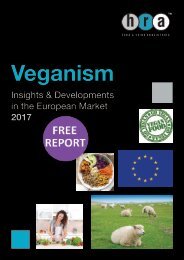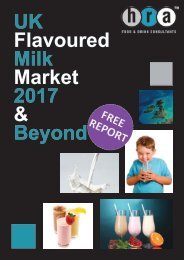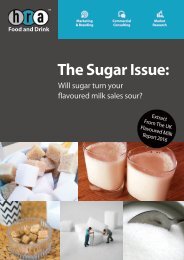FREE-UK-Flavoured-Milk-Report-2016-2017
The backdrop to the UK flavoured milk market is one of relentless change. The removal of the EU milk quotas, the transition to a Western-type diet by emerging economies, the UK sugar debate and the booming sports nutrition industry are all aspects of change that create both challenges and opportunities for the UK flavoured milk market. HRA Food and Drink Marketing has developed this report as a map to guide industry stakeholders. Although volume growth in 2014 was slightly lower than in previous years, the flavoured milk market still has plenty of room for product innovation and development. Overall, we expect the UK flavoured milk market to continue to grow over the medium term, but not without improving its nutritional profile. The sugar debate reached new heights when, in October 2015, Public Health England released a document suggesting Government intervention in the form of a sugar tax (levy). As a consequence, product reformulation has become a priority for all serious players in the market.
The backdrop to the UK flavoured milk market is one of relentless change. The removal of the EU milk quotas, the transition to a Western-type diet by emerging economies, the UK sugar debate and the booming sports nutrition industry are all aspects of change that create both challenges and
opportunities for the UK flavoured milk market.
HRA Food and Drink Marketing has developed this report as a map to guide industry stakeholders. Although volume growth in 2014 was slightly lower than in previous years, the flavoured milk market still has plenty of room for product innovation and development.
Overall, we expect the UK flavoured milk market to continue to grow over the medium term, but not without improving its nutritional profile. The sugar debate reached new heights when, in October 2015, Public Health England released a document suggesting Government intervention in the form of a sugar tax (levy). As a consequence, product reformulation has become a priority for all serious players in the market.
You also want an ePaper? Increase the reach of your titles
YUMPU automatically turns print PDFs into web optimized ePapers that Google loves.
<strong>UK</strong>#FLAVOURED#MILK#<strong>2016</strong>217#<br />
#<br />
greater than the input and therefore there will be a negative nitrogen balance<br />
that will lead to a reduction in body protein.<br />
4.6 The Over-Consumption Argument<br />
To Gain Access<br />
Protein drink brands need to be aware that there is some evidence to<br />
suggest that exceedingly high Purchase levels of protein The intake Full are linked to the<br />
development of chronic diseases.<br />
<strong>Report</strong> Now<br />
Arguments against Excessive<br />
Protein Consumption<br />
Foods rich in protein i.e. meat and<br />
dairy, are often high in saturated fat<br />
Kidneys can be harmed by too much<br />
protein.<br />
Filling up on protein means eating less<br />
healthy vegetables, fruits and<br />
wholegrains. This can put people at<br />
risk of nutrient deficiencies.<br />
Consuming high levels of protein<br />
means excreting more calcium from<br />
the body, increasing the need for<br />
dietary calcium.<br />
Excess protein is converted to fat in<br />
the body so can result in weight gain<br />
Excessive protein consumption of over<br />
200g # a day can raise the risk of<br />
hyperaminoacidemaia,<br />
hyperammonemia and<br />
hyperinsulinemia nausea.<br />
•#<br />
•#<br />
•#<br />
© <strong>2016</strong> Teepee Limited. All Rights Reserved.<br />
The Defence for Protein Drinks<br />
There is growing evidence that<br />
saturated fat is not as bad for us as we<br />
once thought.<br />
Research suggests excessive protein<br />
consumption is unlikely to cause<br />
kidney problems, just exacerbate<br />
existing conditions.<br />
Protein drinks are not intended as longterm<br />
dietary meal replacements and<br />
are recommended to be consumed<br />
with a healthy diet.<br />
Protein from dairy sources contains<br />
calcium.<br />
To Gain Access<br />
Purchase The Full<br />
<strong>Report</strong> Now<br />
Consumption is recommended for<br />
active consumers and combined with<br />
exercise this should not be an issue.<br />
Protein drinks typically only offer a<br />
fraction of the daily limit and, as long<br />
as they are used responsibly in an<br />
otherwise balanced diet, are safe.<br />
In the Western hemisphere, there is a very low chance of an adult<br />
suffering from protein deficiency because the staple foods that are<br />
commonly considered sources of carbohydrates also provide some levels<br />
of protein. Although some children require more protein, in the West most<br />
children consume more protein To than Gain is Access needed.<br />
For adults, the average daily requirement is 0.66g of protein per kilogram<br />
of body weight.<br />
Purchase The Full<br />
An individual’s protein requirements <strong>Report</strong> vary Now but, on average, based on an<br />
adult weighing 70kg, requirements range from 56g and 70g of protein per<br />
day. That is, the maximum amount required is 1g of protein per kilogram<br />
of body weight.<br />
67







